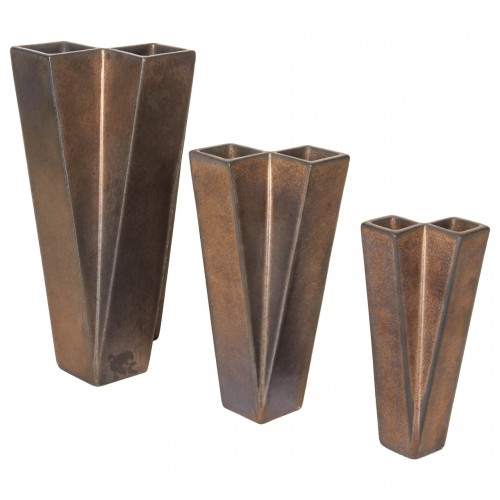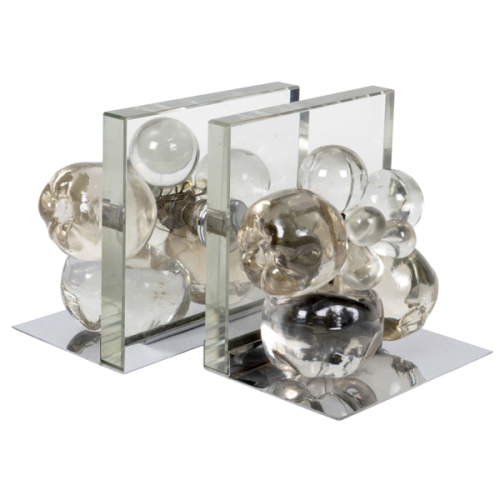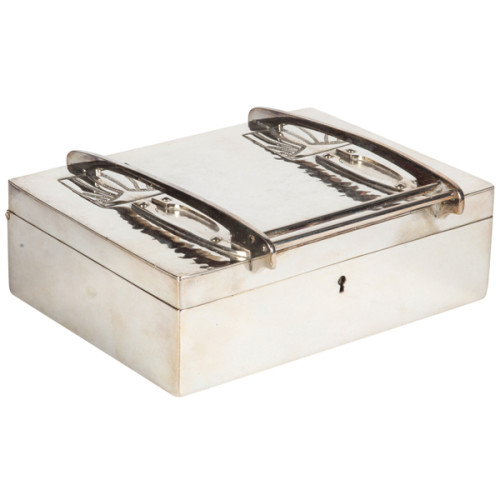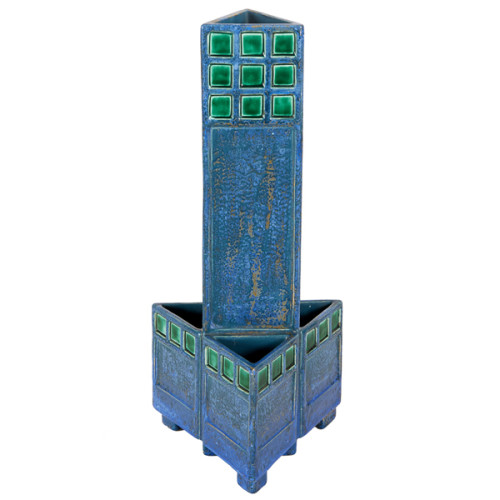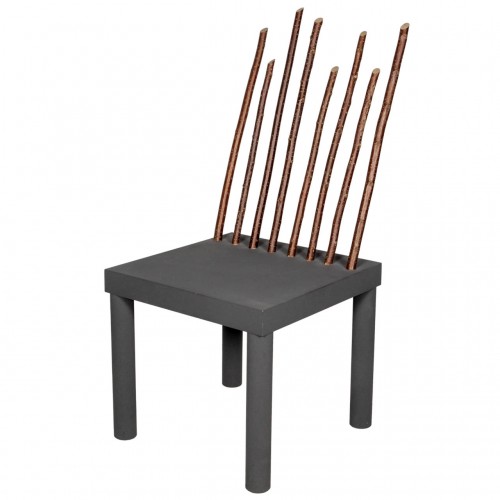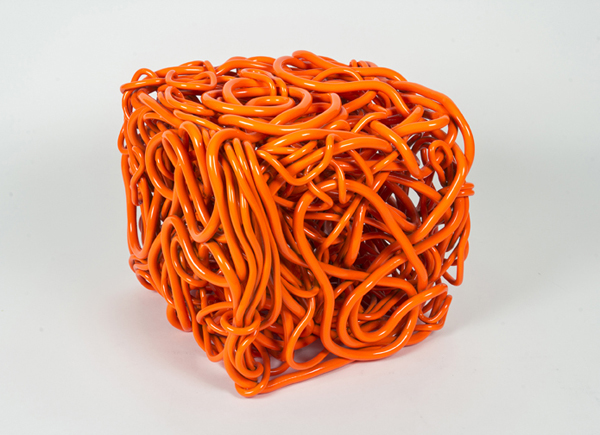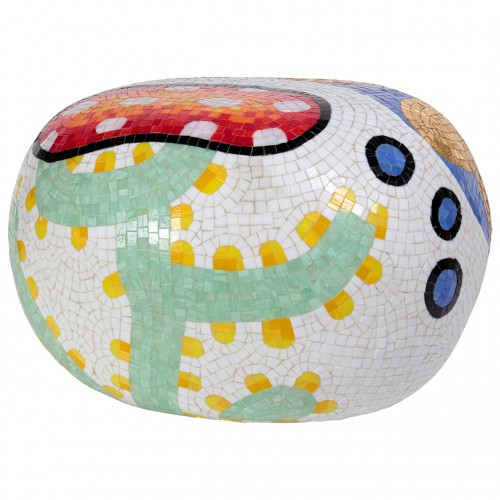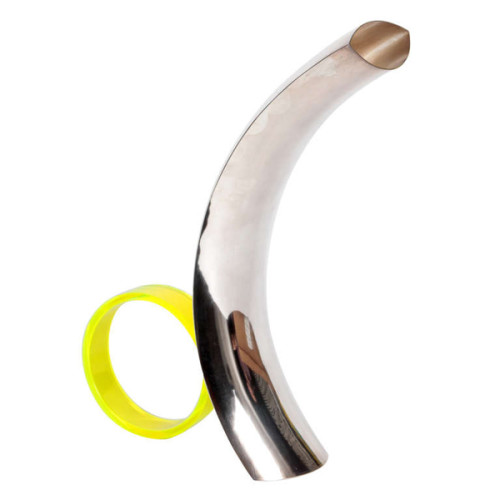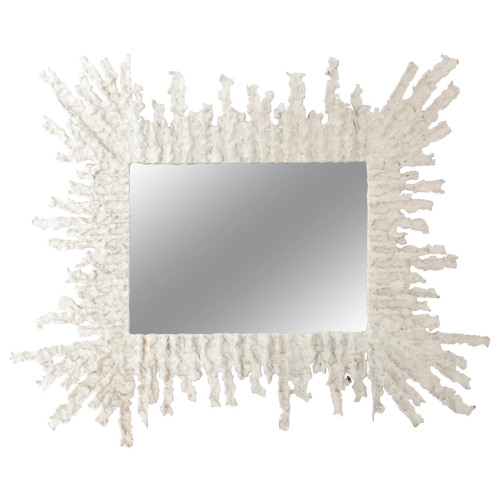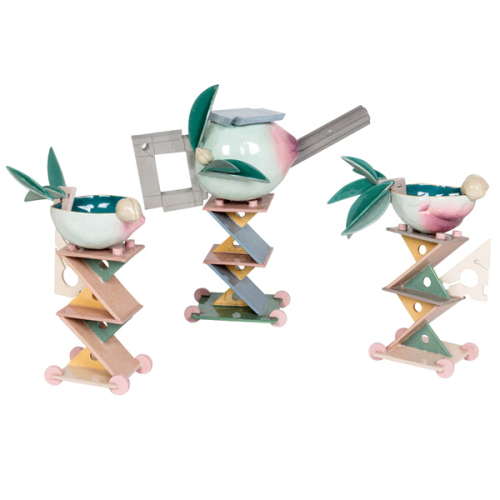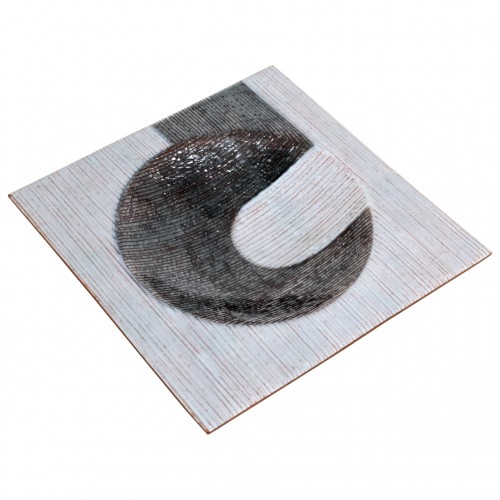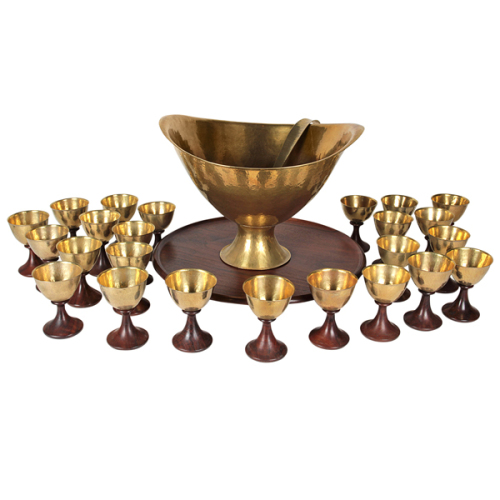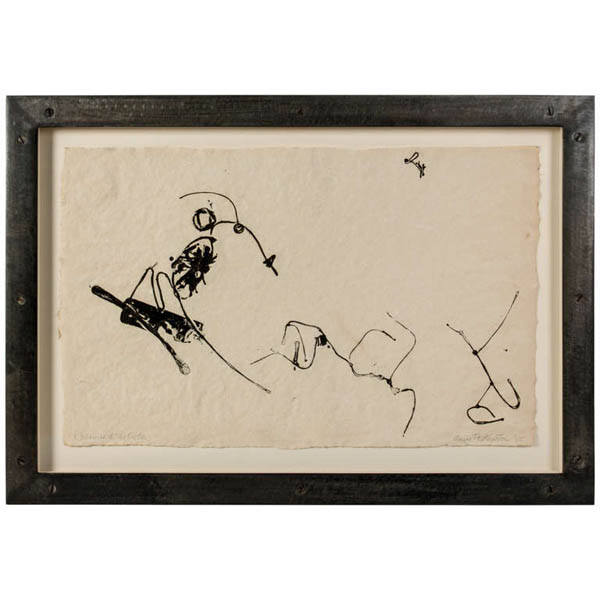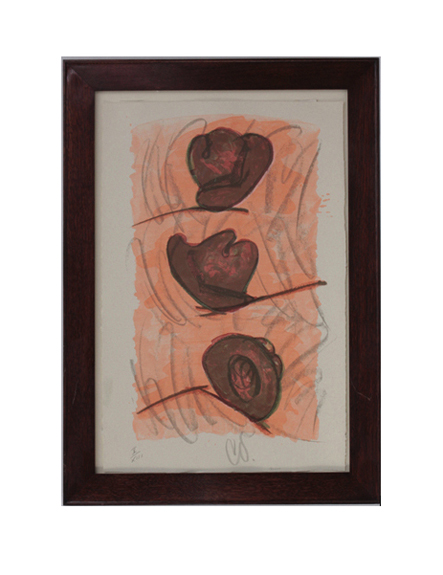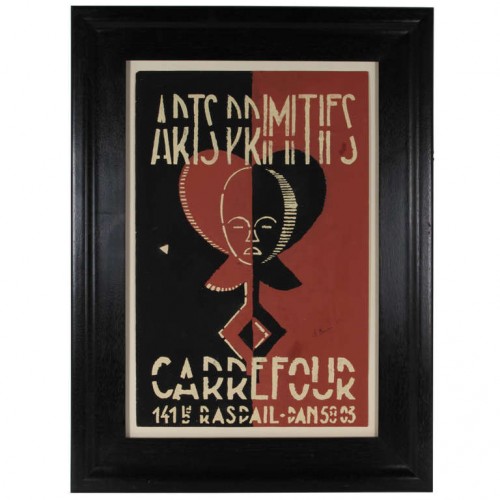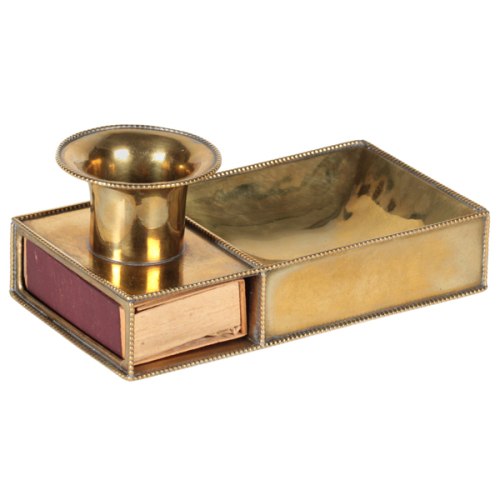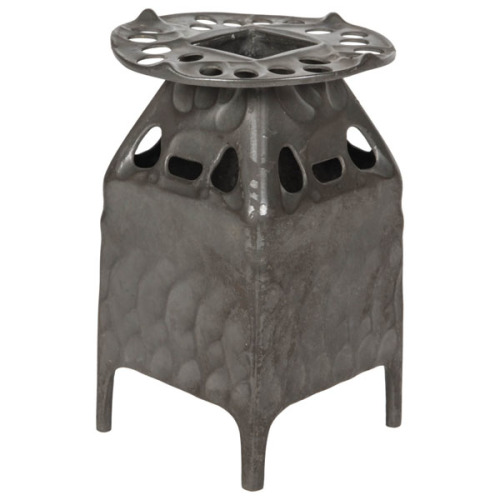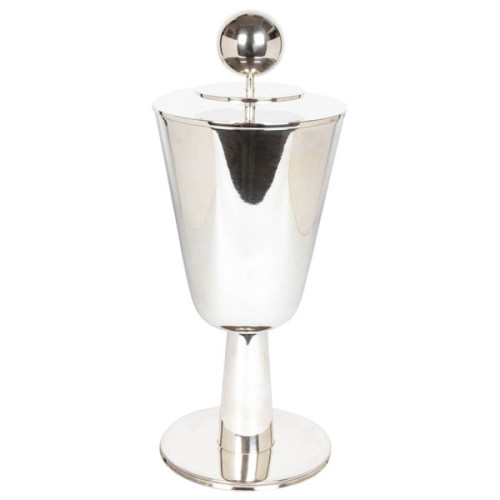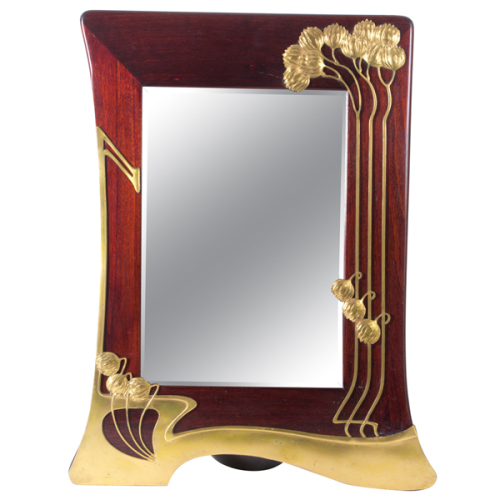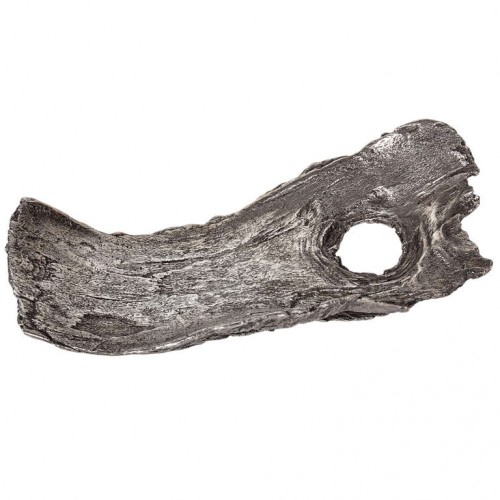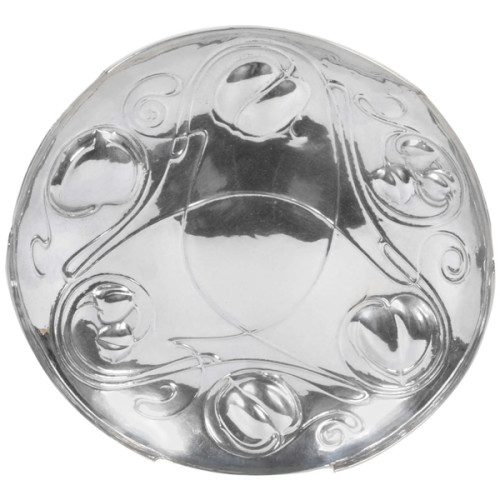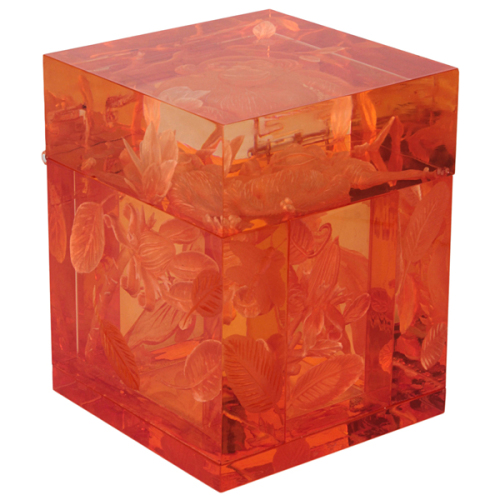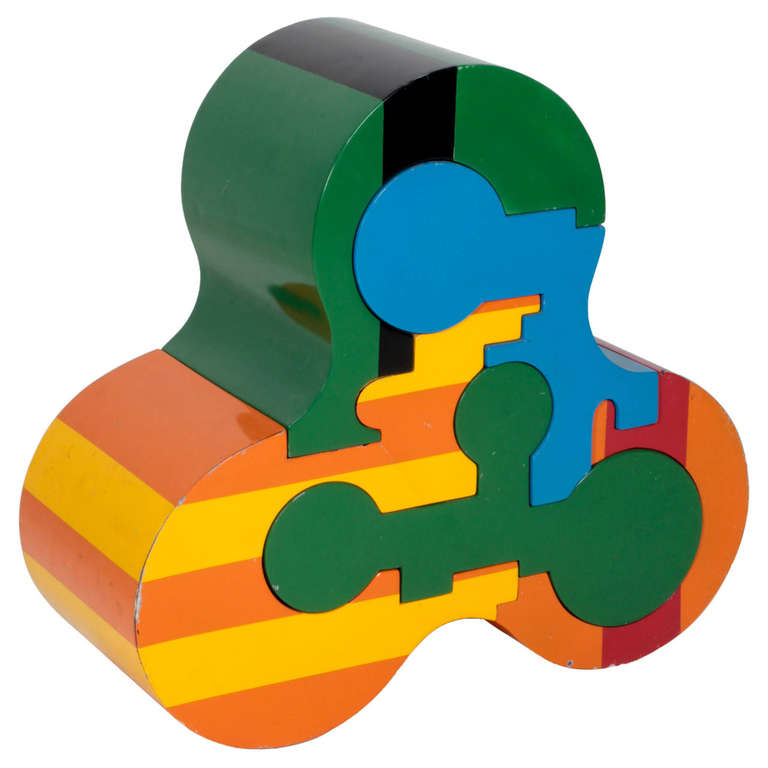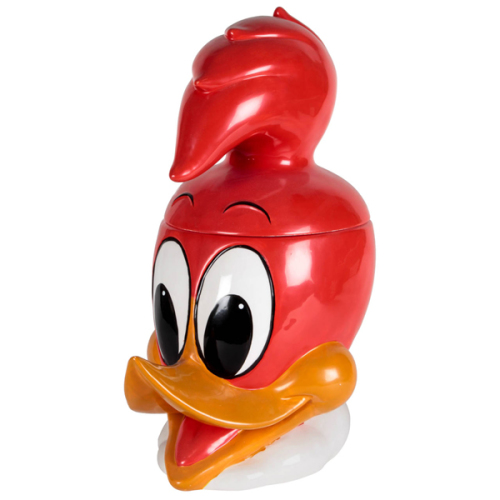product
-
Flavio Poli / Seguso Vetri d’Arte Murano Mid-Century Modern art glass vase c. 1950’s
FLAVIO POLI (1900-1984) Italy
SEGUSO VETRI D’ARTE ItalyVase c. 1950’s
Blue and clear Murano glass
H: 10″ x D: 3″ x W: 4 1/2″
Price: $1,850
Designer, businessman, ceramic artist. Born in Chioggia, he attended the Istituto d’Arte di Venezia and began work as a designer in ceramics. in 1929 he switched to glass and for Libero Vitali’s I.V.A.M. he designed animals, splendid Novecento-style nude figures in massiccio glass, as well as bowls and urns with figures resting on the inside, on lids or as handles. He subsequently collaborated with the Compagnia di Venezia e Murano, with the furnace of Mario and Lino Nason and with the engraver Gino Francesconi. in 1934 he accepted the artistic direction of Barovier, Seguso & Ferro, later to become Seguso Vetri d’Arte, and became partner three years later. Together with the master of the principal team Archimede Seguso, Poli was the author of grandiose lighting installations, of corroded vessels, of sculptures in bulicante glass, of animals in massiccio glass shaped while hot, productions which represented a milestone in the development of Murano glass. At the height of his artistic maturity, in the years between 1950 and 1960 he designed a series of sommerso glass pieces in a Nordic style, essential forms and sharp cold colors, which were awarded prestigious prizes (Compasso d’Oro). After leaving Seguso in 1963, between 1964 and 1966 he organized the artistic glass division at the Societˆ Veneziana di Conterie e Cristallerie.
-
Fontana Arte Italian, Mid-Century Glass “Fruit” Bookends, circa 1950
FONTANA ARTE Milan, Italy
“Glass fruit” bookends c. 1950
Glass, chromium-plated brass
For more information see: Fontana Arte, Una storia Trasparente, Laura Falconi (Milan: Skira, 1998).
H: 5” x W: 3 3/8” x D: 5”
Price: $3,500
-
Vienna Secession, Gisela von Falke Covered Box c. 1905
GISELA VON FALKE (b. 1874) Austria
BERNDORFER METALLWARENFABRIK Berndorf, AustriaCovered box c. 1905
Hand hammered silver-plated box with a stylized floral motif and a riveted buttress handle design, mint green suede interior
Marks: Kayser (in a rectangular box with an arch encircling an eagle above)
For more information on Berndorfer Metallwarenfabrik see: Blühender Jugendstil – Österreich (Art Nouveau in Blossom – Austria), Firmen und Marken (Companies and Marks), Waltraud Neuwirth, II (Vienna: Selbstverlag Neuwirth, 1991), p. 221; Metallkunst, Kunst vom Jugendstil zur Moderne (1889-1939), Karl H. Bröhan (Berlin: Bröhan Museum, 1990) pp. 20-44.
W: 6 1/4″ x D: 5 1/2″ x H: 2″
Price: $4,800
-
Josef Hoffmann Schule / Wiener Kunstgewerbeschule Austrian pottery vase c.1905
THE VIENNA SECESSION
VIENNA KUNSTGEWERBESCHULE
SCHOOL OF JOSEF HOFFMANNArchitectural vase c. 1905
Glazed earthenware
Marks: Austria 7142, arrow (impressed), 71 79EL0, 4911
H: 11 3/4″ x D: 5 1/2″ x W: 5 1/2″
Price: $4,500
-
Andrea Branzi “Cucus” chair c. 1985
Andrea Branzi (1938 – ) Zabro, Italy.
“Cucus” chair c.1985
Lacquered wood, tree branches
Illustrated: Domestic Animals: The Neoprimative Style Andrea and Nicoletta Branzi, (London, 1987) n.p.; Designed by Architects in the 1980s, Julie Capella and Quim Larrea, Barcelona, 1987, p. 37; Anne Bony, Paris Les années 80, 1995, p. 520; Charlotte and Peter Fiell, 1000 Chairs, Cologne, 2000, p. 588
H: 42 3/4″ x W: 19 3/4″ x D: 24″
Price: $19,000
The “Cucus” chair was part of the “Domestic Animals” series
designed in 1985/86 by Andrea Branzi for Zabro.Andrea Branzi's “Domestic Animals” series was designed in 1985 and 1986 for the Italian firm Zabro. Designs were later also manufactured by Zanotta. Andrea Branzi created “Domestic Animals” in collaboration with Nicoletta Branzi, who produced limited edition art clothing for this series. The “Neoprimitive” style in which this collection has been rendered utilizes natural materials such as sticks to create an object that brings archetypal symbols into the home to produce emotional effects. These objects combine technology and nature and the symbols and codes that these entail demonstrating that “a hybrid love between different creatures is possible.” (Branzi, Domestic Animals, 1987, n.p.) With these objects Branzi aims to “domesticate” technological inventions so as to make them a positive presence in man's life.
“The difference between a domestic animal and a trained (or tamed) one lies in the fact that the latter is the outcome of an unnatural and violent attitude, while the domestic animal establishes the dream of a loving relationship with man.” (Branzi, Domestic Animals, 1987, n.p.)Andrea Branzi, architect and designer, born in Florence in 1938, where he graduated in 1967, lives and works in Milano. From 1964 to 1974 he was a partner of Archizoom Associati, first vanguard group internationally known, whose projects are preserved at Centro Studi e Archivio della Comunicazione in Parma and at Centre Georges Pompidou in Paris.
Since 1967 he works in the fields of industrial and research design, architecture, urban planning, education and cultural promotion.He is Professor at the Third Faculty of Architecture and Industrial Design of Politecnico di Milano. -
Forrest “Frosty” Myers Orange cube 2008
FORREST (FROSTY) MYERS (1941- ) USA
Orange cube 2008
Orange anodized and contoured aluminum wire manipulated into a cube form
Signed: Orange Cube, 08, Forrest Myers (on plaque)
For more information see: Who Was Who in American Art (Madison, Conn.: Sound View Press, 2003-2004 25th Edition), Dictionary of American Sculptors: 18th Century to the Present, Glen Opitz (Poughkeepsie, NY: Apollo, 1984).
Dimension: 10 1/2″ cube
Price: $15,000
A sculptor and art teacher born in Long Beach, California, Forrest Myers settled in Brooklyn, New York. Myers studied at the San Francisco Art Institute. His teaching venues include the San Francisco Art Institute, School of Visual Arts in New York, Kent State University, and the Parsons School of Design. His studio is in Brooklyn.
In the early 1980s, Forrest Myers was applying Buckminster Fuller's principles of tensegrity and repeated tetrahedrons into his designs for furniture. This exploration culminated in the use of aluminum wire that becomes structural when bent and pressed into a dense tangle.
-
Marcel Wanders, One Morning They Woke Up, mosaic table/stool 2004
MARCEL WANDERS (1963-) The Netherlands
“One morning they woke up” mosaic occasional table or stool 2004
Gilt and lively colored glass mosaic, fiberglass body
H: 13″ x D: 17″
Price: $18,500
Marcel Wanders (1963) grew up in Boxtel, the Netherlands, and graduated at the School of the Arts Arnhem in 1988 with a cum laude certificate. He is now an independent industrial product designer operating out of Amsterdam where he has his own studio, Marcel Wanders studio. Marcel continues to work on diverse products and projects for Cappellini, Mandarina Duck, Magis, Droog Design and Moooi amongst others. For the latter he is associated as creative director. Marcel also co-operates in other design-related projects, such as the Vitra Summer Workshop where he was project leader for the second time. Also he was a juror for various prizes like the Rotterdam Design Prize (for which his own products were nominated several times) and the Kho Liang Ie prize. He lectured at SFMoMA, Limn the Design Academy and has taught at various design academies in the Netherlands. Marcel won the Rotterdam Design Prize (public prize) for the Knotted Chair, and received several other awards including the George Nelson Award (Interiors magazine) and Alterpoint Design Award 2000. In the 2001, Marcel has been nominated in the category ‘designer of the year’ in WIRED magazine’s 2001 wired rave awards. Designs of Marcel Wanders have been selected for the most important design collections and exhibitions in the world, like the Museum of Modern Art in New York and San Francisco, the Stedelijk Museum in Amsterdam, Museum Boijmans van Beuningen in Rotterdam, the Central Museum in Utrecht, and various Droog Design exhibitions. In the book ‘Wanders Wonders, design for a new age’ (1999) which accompanied a solo exhibition in Museum ‘t Kruithuis in Den Bosch, the most important products are shown, from the Knotted Chair to the Shadows lamps and from the Nomad Carpet to the Eggvase. Works of Marcel have been published in all leading design magazines.
-
Flavio Poli / Seguso Vetri d’Arte Brown Murano Art glass vase c. 1950’s
FLAVIO POLI (1900-1984) Italy
SEGUSO VETRI D’ARTE ItalyVase c. 1950’s
Asymmetric vase in a dark brown Murano glass cased inside with a layer of pale green and clear glass
H: 10 1/2″ x W: 5 1/2″ x D: 2 3/4″
Price: $4,000
Designer, businessman, ceramic artist. Born in Chioggia, he attended the Istituto d’Arte di Venezia and began work as a designer in ceramics. in 1929 he switched to glass and for Libero Vitali’s I.V.A.M. he designed animals, splendid Novecento-style nude figures in massiccio glass, as well as bowls and urns with figures resting on the inside, on lids or as handles. He subsequently collaborated with the Compagnia di Venezia e Murano, with the furnace of Mario and Lino Nason and with the engraver Gino Francesconi. in 1934 he accepted the artistic direction of Barovier, Seguso & Ferro, later to become Seguso Vetri d’Arte, and became partner three years later. Together with the master of the principal team Archimede Seguso, Poli was the author of grandiose lighting installations, of corroded vessels, of sculptures in bulicante glass, of animals in massiccio glass shaped while hot, productions which represented a milestone in the development of Murano glass. At the height of his artistic maturity, in the years between 1950 and 1960 he designed a series of sommerso glass pieces in a Nordic style, essential forms and sharp cold colors, which were awarded prestigious prizes (Compasso d’Oro). After leaving Seguso in 1963, between 1964 and 1966 he organized the artistic glass division at the Societˆ Veneziana di Conterie e Cristallerie.
-
Linda Lee Johnson, Organic Shaped Sculpted Silver bird bowl Vessel XII c. 2004
LINDA LEE JOHNSON (1944-2018) Washington, DC
Sculpted silver bowl “Vessel XII” c. 2004
Irregular organic shaped lost wax cast silver bowl with an irregular shaped top and one pierced hole (3/4 inch). Approx. silver weight is 80 troy ounces.
Marks: Logo monogram, 5/20, initial monogram
H: 5 1/4″ x W: 8 1/2″ x D: 7 1/4″
At the age of three Linda Lee Johnson was given a handmade Native American bracelet from her father, a naval aviator, and subsequently another every time they crossed the country. By the time she was seven, she had seven bracelets which she never removed. She was an American field service exchange student to Greece in high school. It was here that she developed her love of theater, sculpture and ancient
jewelry. She graduated from the University of California, Berkeley, in English literature and dramatic art and immediately began to study sculpture making.She was a founding member of the Berkeley Repertory Theatre, and a professional actress for nineteen years with many major roles in New York city and regional theaters around the country and abroad.
She studied jewelry making in New York City 1984-88.
In 1986, she was asked to place her pieces in Tiffany & Co. in all major stores. At the same time she had many featured pieces of jewelry, small sculpture and functional objects in the Museum of Modern Art design store.
Barney’s New York began to represent her in l989, where her jewelry and limited edition decorative art work are still found today.
She lived in Washington DC and the Adirondack Mountains where she continued to craft and sculpt her jewelry and decorative works of art until her passing in 2018.
-
Wolfgang Gessl Unique sterling silver Arc pitcher with acrylic handle 1990
WOLFGANG GESSL (b. 1949) Austria
Arc pitcher – unique 1990
Hand wrought silver in a rounded arching form with a cylindrical luminous yellow-green acrylic handle
Marks: Wolfgang Gessl (script impressed signature), WO.GE (in a rectangle), Swedish assay mark for Stockholm, 925 (silver guarantee in a rectangle), Q10 (in a rectangle)
Illustrated: Gold and Silversmith Wolfgang Gessl: Exceeding Geometry, Kerstin Wickman, p. 17, cover.
H: 13 1/2″ x W: 10 ¼” x D: 4 ½”
Price: $27,500
Wolfgang Gessl was born in 1949 in Vienna, Austria and trained as a goldsmith with Professor Hans Angerbauer. Upon moving to Sweden, Gessl studied under the eminent silversmith Sigurd Persson at Konstfack, the National University of Art, Craft and Design in Stockholm, Sweden.
Wolfgang Gessl has had fifteen solo exhibitions including shows at The National Museum, Stockholm and The Royal College of Art in London. His metalwork has been widely exhibited in Sweden, Europe and the U.S and his pieces can be found in many private collections throughout the world. He has taught at Konstfack for more than twenty-four years, and continues to live and work in Stockholm.
-
Marcello Fantoni Torched bronze and white plaster painted mirror 1950’s
MARCELLO FANTONI (1915-2011) Italy
Starburst mirror 1950’s
Torched bronze and original white plaster painted finish.
Marks: Fantoni, Firenze, Italy (hand script)
***This mirror has great style and character.
Overall dimension: H: 26″ x L: 33″ x D: 4″
Mirror dimension: H: 12″ x L: 17″Price: $17,500
Born in Florence on October 1, 1915, Marcello Fantoni registered at the Institute of Art at Porta Romana in 1927 to attend the course The Art of Ceramics, which at that time was taught by the ceramist Carlo Guerrini, artistic director of the Cantagalli factory. Other teachers also contributed to his artistic formation including Libero Andreotti and Bruno Innocenti in sculpture and Gianni Vagnetti in the figure. He graduated in ’34 as a ‘maestro’ of art, and began working as a ceramist. In 1936, after having worked for a few months as the artistic director of a factory in Perugia, he established himself at Villa Fabbricotti in Florence and founded the Fantoni Ceramic studio. It’s production of serial and unique pieces had remarkable success at the Florentine Arts and Crafts Exhibit in ’37, revealing itself in line with the most recent tendencies, so much so that at the beginning of hostilities his production had already received notable artistic and commercial attention in Italy and abroad. After the war years, when Fantoni was involved in the resistance, in ’46 he began the creative and productive fervor that will allow him to enlarge his company, reaching at the beginning of the next decade the impressive size of over fifty collaborators. Among his employees were many students who, in ceramics and other fields, would become excellent artisans and even famous artists. In the following decades, especially between 1950 and the 70’s, the success of his work continued to increase, his unique pieces of sculpture and sculptural work, characterized by a design in step with the contemporary artistic currents, like archaic stylization inspired by Etruscan models, rendered modern because of their modern handling of materials, glazes and colors. For this original spirit of modernity, his works are in many private collections and in some of the most important museums of the world: in the United States his works can be seen at the Metropolitan Museum of Art of New York, the Brooklyn Museum, the Museum of Fine Art of Boston, the Currier Gallery, the Syracuse Museum. In Britain they are in the Victoria and Albert Museum of London, the City Art Gallery of Manchester, at Royal Scottish Museum of Edinburg. In Japan they are present at the Museum of Modern Art of Tokyo and Kyoto. In Italy they are represented at the International Museum of Ceramics in Faenza, the National Bargello Museum and at the Gabinetto Disegni e Stampe of the Uffizi. In his long and versatile career, Fantoni has completed works for churches, public and private buildings, schools, cinemas, theaters and ships cementing himself in both figurative and abstract ceramics and various metals, and qualifying himself also in the field of medalism. In 1970 he founded the International School of Ceramic Arts at his laboratory in via Bolognese in Florence. Fantoni died at the age of 95 in 2011.
-
Erik Tidäng Sculptural Artichoke Vase, 1999
ERIK TIDÄNG (b. 1973) Stockholm, Sweden
Sculptural “Artichoke” vase 1999
Oxidized and waxed iron, silver
Marks: ERIK, 2/2
H: 11 ½”
Price: $17,500
***The only other Artichoke vase (Number 1 out of 2) is in the permanent collection of the Swedish National Museum, Stockholm.
Erik Tidäng was born in Gothenburg, Sweden in 1973. He received his Bachelor and Master of Fine Arts from the Institution for Metaldesign, Konstfack.
-
Ane Christensen Contemporary British Sterling Silver Bowl 1999
ANE CHRISTENSEN (b.1972) born in Copenhagen, Denmark/ based in London, UK
Bowl 1999
Sterling silver
Marks: AKC, 925, Z, British hallmarks
H: 2 ½” x L: 12”
Price: $5,950
The starting point for all of metalworker Ane Christensen’s tableware is a single sheet of metal. Her aim is to develop a three dimensional object from a flat sheet without adding or removing any elements. Japanese paper packaging influences Ane’s work, but a more important influence is the half finished or half demolished structures of building sites that she says can hold unexpected sculptural qualities.
Ane graduated from the Royal College of Art and has since been involved in exhibitions in London, Denmark and Copenhagen, including more recently at Collect, V&A.
Ane makes pieces in a variety of metals including silver, stainless steel and powder coated copper.
-
Gustavo Perez, Mexican Contemporary Pottery, Ceramic vase 2000
GUSTAVO PEREZ Mexico
Stoneware vase 2000
Black, randomly positioned rectangles on a cream / sandy base with a pinned overlap detail
Signed: GP 2000-68
H: 9 1/4″ x D: 6 1/2″
Price: $5,500
Gustavo Pérez makes vessels that are simple, smooth and symmetrical. Their elegance is due to the precision of the incised lines and other markings on the pots. While using the same clay body—sand colored stoneware—throughout his work, the artist achieves a wide range of form and pattern and includes slowly undulating walls beneath the subtly incised surfaces.
Gustavo Pérez works are incessantly experimental. There have been parallel lines, calligraphic traces, geometric cuts into the surface, minimalist vessels, recollections of pre-Hispanic vases and references to other ancient cultures.
The ceramics of Gustavo Pérez are distinguished by eliminating superfluous details, by synthesis of his elements. During the past two decades he has created a visual language that seems closely aligned with music. Pure in form, with a significant structure, completely abstract and without specific associations, his language of line, the bending of forms, and the definition of the vessel mark his work as a distinctive voice. The form is not just a container or a receptacle; it is architecture.
-
PER SAX MOLLER / Scandinavian Modern Sterling sculptural centerpiece 2000
PER SAX MØLLER (b. 1950) Denmark
Round sculptural centerpiece with geometrical shapes 2000
Sterling silver
Marks: PER SAX MØLLER, Copenhagen, 925s, Sterling
Exhibited: Danske Sølsmede-nye arbejder (Danish silversmiths-new work), Museet på Koldingshus, 2002.
Diameter: 8 ¼”
Price: $12,500
The silversmith Per Sax Møller was trained in the Danish silver tradition with Jeweler to the Royal Danish Court, A. Michelsen, from 1968-1972. The workshop specialized in style copies and modern silver, which during the 1900’s was designed by architects such as Thorvald Bindesbøll, Kay Fisker, Erik Herløw, Tove and Edvard Kint-Larsen, among many others.
After completing his apprenticeship, he worked at Preben Salomonsen’s workshop in Copenhagen, mainly creating style copies for stores such as Tiffany, Bloomingdale’s and Aspery. Here, the ancient silversmith’s craft he had learned at A. Michelsen, was further honed. During the years 1973-1975, he attended classes at Guldsmedehøjskolen, but he was disappointed in the low standard of teaching and therefore did not graduate.
He found the opportunity for a far richer artistic education as a conscientious objector, stationed at the art museum Louisiana in Humlebæk, outside Copenhagen. He spent more than a year here, surrounded by the works of Henry Moore, Arp, Calder, Laurent and Danish artists such as Astrid Noack, Ejler Bille, Sonja Ferlov Mancoba, Villy Ørskov and many more, which left a deep and profound mark.In 1976, Per Sax Møller established himself in a workshop alongside goldsmith Jørgen Bindesbøll, in St. Kongensgade in Copenhagen. Over the next couple af years, he also joined the association “Danske Sølvsmede” in exhibitions throughout Scandivavia. He retired from the workshop with Jørgen Bindesbøll in 1980, but continued to create works in rented space. To help earn a living, he drove a city bus and worked for Folketeateret in Copenhagen, creating theatre sets.
Jørgen Bindesbøll moved to Møn in 1984, and Per Sax Møller took over his workshop in St. Kongensgade. Soon thereafter, he established himself in a workshop in Pilestræde, Copenhagen, and then in 1992, he took over silversmith Kay Bojesen’s workshop in Bredgade 47, where he resides today.
In the mid 1990’s Per Sax Møller rejoins “Danske Sølvsmede”, and in 1999 he succeeds silversmith Ib Andersen as president of the association. As president, he revitalizes Danish silver by initiating the exhibition Danish Silver 2000, which takes up most of the space in the museum Koldinghus and becomes one of the largest manifestations of Danish silver. During one summer month, the exhibition was visited by 30,000 guests.In 2002, Per Sax Møller resigns the presidency of “Danske Sølvsmede” to once again concentrate on his own works. Per Sax Møller has received Danish State Arts Foundation grant in 1979, 1997, 2000 and 2002. His works are represented at Oslo Museum of Art and Design, Danish Museum of Art and Design, at the museum Koldinghus and in private collections in Europe, USA and Canada.
-
Peter Shire Memphis Group California Art Pottery Rare Early “Peach Tea Set” 1980
PETER SHIRE (b. 1947) USA
Rare and early “California Peach” teaset 1980
Handmade earthenware with polychrome glazes
Made by Shire at his studio in Echo Park, CaliforniaSigned: Shire 1980 EXP (painted on base of each)
Model illustrated: Tempest in a Teapot, the Ceramic Art of Peter Shire, Norman M. Klein et al. (New York: Rizzoli, 1991) p. 11.
Teapot H: 10” x W: 11 1/4” x D: 5 1/2”
Pair of teacups H: 7 3/4” & 8”Price: $8,500
Peter Shire (born 1947) is a Los Angeles artist. Shire was born in the Echo Park district of Los Angeles, where he currently lives and works. His sculpture, furniture and ceramics have been exhibited in the United States, Italy, France, Japan and Poland; Shire has been associated with the Memphis Group of designers, has worked on the Design Team for the XXIII Olympiad with the American Institute of Architects, and has designed public sculptures in Los Angeles and other California cities. Shire has been honored by awards for his contribution to the cultural life of the City of Los Angeles.
-
Gio Ponti / Del Campo enamel bowl c. 1955
GIO PONTI (1891-1979) Italy
DEL CAMPO ItalyGraphic enameled bowl c. 1955
Silver foil enameling on copper with a striated silvery white body with a dark silver grey modernist graphic.
Marks: del campo, ITALY (etched marks)
For more information on Ponti and Del Campo see: Gio Ponti, ed. Ugo La Pietra (Rizzoli International Publications: New York, 1996); Gio Ponti: the complete work 1923-1978, Lisa Licitra Ponti (Cambridge, MA: The MIT Press, 1990)
8” square
1″ HeightPrice: $3,200
-
Lawrence Hunter Hand Wrought Brass and Walnut Punch Set c.1965
LAWRENCE HUNTER, San Diego, California
Punch Bowl set c.1965
Hand hammered and hand wrought large asymmetric punch bowl with matching ladle, turned walnut pedestal platter and twenty four hand wrought brass and walnut pedestal shape goblets
Marks: HUNTER spelled out within a large outline of an H (name logo and monogram mark on all pieces)
Punchbowl H: 13 ½” x Dia: 16”
Cups: H: 5” x Dia: 3 ½”
Serving tray: H: 2 ¾” x Dia: 17 ¾”Price: $11,500
By repute, this elaborate punch set was a custom commissioned work for a West Coast collector and likewise was purchased directly from Larry Hunter in the mid-1960’s for $2,500.
Lawrence “Larry” Hunter grew up in San Diego and received a BA from San Diego State College in the late 1950s. As an undergraduate, Hunter studied with John Dirks, who founded the furniture design program at San Diego State College, and Ilse Ruocco. While completing an MA at University of California, Los Angeles, Hunter worked in clay and was a teaching assistant for Laura Andreson. Hunter was hired to teach general crafts and design classes at San Diego State in 1962, and later inherited the furniture design program from Dirks.
Hunter was a member of the Allied Craftsmen of San Diego and exhibited furniture regularly in the California Design series at the Pasadena Art Museum and the California Crafts series at the Crocker Art Gallery in Sacramento. Hunter led the San Diego State furniture design program until the late 1980s, helping the furniture program to become a vital part of the community. Featured artists will include Toza and Ruth Radakovich, Rhoda Lopez, Jack Hopkins, Arline Fisch, Ellamarie and Jackson Woolley, Larry Hunter, Kay Whitcomb, Ilse Ruocco, and James Hubbell. It was at this same time that Constantine’s, a New York fine wood merchant, offered plans for clocks with wooden works; that John Gaughan made a skeletal grandfather’s clock with wooden works; and that Larry Hunter, who taught at San Diego State, used the clock form to explore kinetic sculpture within a functional format. Hunter eschewed the older traditional adornment of the case and focused upon visible works so that people could watch time actually move. -
Claire McCarthy Falkenstein, Chase, Structure-graphic, unique impression of metal sculptural forms on handmade paper (artist’s proof) 1955
CLAIRE MCCARTHY FALKENSTEIN (1908-1997) Coos Bay, OR
“Chase” 1955
Structure-graphic, unique impression of metal sculptural forms on handmade paper (artist’s proof), steel frame.
Signed: “Claire Falkenstein ‘55” (on bottom right corner), “E prevue d’artiste” (on bottom left corner), #6, “Chase”, Structura grafica, Milano, Italy, Giorgo Unglio Shop (label on back)
*** A related structure-graphic from 1952-55 is in the collection of the Yale University Art Gallery.
Framed: H: 15 11/16” x 22 9/16”
SOLD
Falkenstein was born in the first decade of the century and was still hard at work in the last. Her life was precisely coincident with the 20th century, and she was a full participant in the tumultuous events in the art world. Her work incorporated modern technology, process, assemblage, chance, light, space, and what has been called “anti-form” as creative principles. Falkenstein was a contemporary of the Abstract Expressionists but, in fact, started sooner, lasted longer, and surpassed them in formal vocabulary, in the variety of materials she used and in her highly experimental techniques. Starting her career, (working, teaching and exhibiting} in San Francisco until 1950 when she moved to Paris for a dozen years to pursue her art career, where her association with critic Michel Tapié and his group Art Autre developed into many commissions including the gates at the home of her longtime friend Peggy Guggenheim in Venice, Italy. She returned to Venice, California in 1960. In other words, like a heat-seeking missile, she found and participated in the liveliest and most challenging art centers of the time. During her career she created over four thousand sculptures, paintings, and drawings, and became known for her innovative and often controversial abstract public art. Among major commissions were the windows for St. Basil’s Catholic Church, and fountains at California Federal Savings (now destroyed) and California State University. Putting her in the immediate milieu of many of the century’s greatest artists, she studied, worked, competed, collaborated and, in several cases, became close personal friends with several, including Alexander Archipenko, Clyfford Still, David Smith, Hans Arp, Mark Tobey, Antoni Tapies and Alberto Giacometti. Many years later, she said: “…there were marvelous things, marvelous people, but I took it all in stride. I was completely engrossed in what I was doing. There were people who were accustomed to being treated with deference and I guess I didn’t – and I guess that’s why they got interested.” (Falkenstein, Oral History, UCLA) Throughout Falkenstein’s career, she created a prodigious amount and variety of work, well beyond the traditional categories of painting and sculpture. She explored printmaking, ceramics, functional art, jewelry, and public monuments — ranging from the miniature (jewelry) to the colossal (50’ fountains and 100’ stained glass windows). And in each of these areas, her accomplishment has been consistently and unmistakably of historical significance.
-
Claes Oldenburg / Meyer Shapiro Portfolio, One of the 12 (limited edition) prints 1974
CLAES OLDENBURG (b. 1929) USA
MEYER SCHAPIRO PORTFOLIO 1974
One of the 12 (limited edition) prints (from the Meyer Schapiro Portfolio) 1974
Limited edition print 1974
Signed: CO (artist’s monogram) 1974 X/XIII
Image H: 31 1/2” x W: 18”
Framed: H: 35 1/4” x W: 23 1/4”
-
GALERIE CARREFOUR 141 Boulevard Raspail, Paris Vérité Collection Wood block print poster, ARTS PRIMITIFS, CARREFOUR, 141 BD RASPAIL, DAN 5803 c. 1948
GALERIE CARREFOUR 141Boulevard Raspail, Paris
Vérité Collection Wood block print poster “ARTS PRIMITIFS, CARREFOUR, 141 BD RASPAIL, DAN 5803″ c. 1948Float mounted in a finely contoured oak frame.
Inscribed to: A Monsieur E Mme Breton, Vérité Image dimension:
H: 19 1/2″ x W: 12 3/4″
Framed dimension: H: 26 3/4″ x W: 19 3/4”Price: $9,000
The Vérité Collection of primitive arts started after World War 1 in 1920. Pierre Vérité, a young artist started buying primitive art before anyone else. Vérité opened a small store selling exclusively tribal art in 1931 in conjunction with the Paris Colonial Exposition. Pierre Vérité regarded “primitive arts” as art, and it is the raw power of these primitive pieces that changed the history of 20th-century European culture. In 1936, he opened the Galerie Carrefour on the Boulevard Raspail, which was a hangout for artists and collectors such as Pablo Picasso, Helena Rubenstein, Nancy Cunard and Andre Breton. Tribal art was one of the key influences on Pablo Picasso and he often dropped into Pierre Vérité’s Galerie Carrefour in Paris to buy masks and carvings from Africa and Oceania. Henri Matisse was also a regular visitor, as were other artists such as Fernand Léger and Maurice de Vlaminck, while Vérité used to browse Parisian flea markets with André Breton, Surrealism’s chief theorist. In the decades that followed the opening of the gallery, the Vérité family’s client list grew to include Hollywood stars and leading museum curators, as well as some of the greatest names in 20th-century art. Vérité very quickly became the most important art dealer for primitive arts. In the 1948, Pierre’s son Claude became increasingly involved in the gallery. He went on African expeditions, collecting objects and information, and took photographs to document his travels, while his wife Jeannine was running the gallery operations. With Claude and Jeannine joining the gallery, Galerie Carrefour showed at all “Art Primitifs” exhibitions in Europe and the United States. The gallery established itself as the most important player in tribal arts in the world and exhibited until the 1990’s.
-
Josef Hoffmann / Wiener Werkstätte Brass Candleholder and Match Safe 1906
JOSEF HOFFMANN (1870-1956) Austria
WIENER WERKSTÄTTE (1903-1932) ViennaCandlestick holder and match safe 1906
Hand wrought brass with beading around the perimeter of the edgesMarks: JH monogram, WIENER/WERK/STÄTTE, rosemark
Model illustrated: Österreichische Werkkultur, Max Eisler (Vienna: Österreichischer Werkbund, 1916). (slipcovered); Wiener Werkstätte G. M. B. H. catalog (December 1923), p. 114
H: 1 3/4″ x D: 2 5/16″ x W: 4 1/2″
Price: $4,500
-
Karl Berghof / Kayserzinn Extremely Rare German Jugendstil Art Nouveau Pewter Vase 1904
KARL BERGHOF Germany
J. P. KAYSER SOHN Krefeld, GermanyVase 1904
Pewter squared vase with round flange top, open work details
Marks: Kayserzinn 4541 7 (in a raised oval)
Illustrated: Zinn des Jugendstils, Eckard Wagner (Cologne: Rheinland-Verlag, 1978), p. 63, cat. no. 148; J. P. Kayser Sohn Krefeld: Fabrik kunstgewerblicher Metallgegenstände, Musterbuch 1907 (Munich: Verlag Dry, 1982) p. 46.
***This is an extremely rare, other worldly Kayserzinn form.
H: 7” x Top W: 4 ¾” x Base: 4 x 4 square
-
Max Läuger Germany Unique Jugendstil footed bowl inlaid with gold mosaic 1906
PROF. MAX LÄUGER (1864-1952) Karlsruhe, Germany
Unique Jugendstil ceramic footed bowl inlaid with gold mosaic 1906
Light and dark green glazed earthenware inlaid with mosaic gold glass squares on four cylindrical feet.
Marks: ML, K (monogram)338 (incised), 4., MUSTER B.., GESCHTZ
For other mosaic inlaid works by Max Läuger see: Max Laeuger (1864-1952): sein graphisches, kunsthandwerkliches und keramisches Oeuvre, Elisabeth Kessler-Slotta (Saarbrücken: Saarbrücker Druckerei und Verlag, 1985) pp. 178/179; Europäisches Kunstgewerbe 1927, Stadtisches Kunstgewerbe-Museum zu Leipzig, (Leipzig: E.A. Seeman, 1928) p. 86; Deutsche Kunst und Dekoration vol. XII “Professor Max Laeuger Karlsruhe”, pp. 221-237; Modernism: Modernist Design 1880-1940 (The Norwest Collection, Norwest Corporation, Minneapolis), Alastair Duncan (Woodbridge, Suffolk, England: The Antique Collector’s Club, 1998), p. 86.
H: 5 3/4″ x Dia: 7 1/4″
Max Laeuger (or Läuger) was born in Lörrach on September 30, 1864. Laeuger was a self taught ceramicist, studied at the Karlsruhe Polytechnic a hundred miles to the north-west of Lörrach (now Karlsruhe University) and eventually became a professor at the university. In 1895 after travelling throughout Europe visiting the major cultural centers to study art he was appointed director of the art pottery department of Tonwerke Kanderne close to his home town. He stayed there until 1913 and later took up a similar position at Majolika-Manufaktur in Karlsruhe.
From 1921 he had his own workshop on the premises formerly owned by the company and produced designs there. The work produced fell into three categories, slip decorated wares designed by Laeuger but produced entirely by the factory, pieces made at the factory but decorated and glazed by Laeuger and one-off pieces by the professor made from beginning to end in his own workshop. All were marketed by Majolika-Manufaktur. Laeuger’s one-off pieces had the brushed initials ‘ML’ and the other works were marked ‘LAEUGER’ or ‘PROF. MAX LAEUGER’
Through the thirties and into the Second World War he worked on his own, but after his workshop was destroyed in 1944 he returned to Lörrach where he died on December 12, 1952. Laeuger was a major figure in German ceramics. His designs and his glazes had ‘organic’ characteristics that are his signature design and his work is much sought-after by collectors. Examples of Laeuger pieces are on display at the Badisches Landesmuseum in Karlsruhe.
-
Karl Koepping (attr.) / Grossherzogliche Sächsische Fachschule, Germany Tall Pair of Liquor glasses c. 1900
KARL KOEPPING attr. (1848-1914) Germany
GROSSHERZOGLICHE SAECHSISCHE FACHSCHULE Weimar, Germany
Tall Pair of Liquor glasses c. 1900
Blown golden yellow glass
H: 8 1/2″
-
Alfred Grenander / W. Kummel 1904 St. Louis Exhibition cabinet, unique 1904
ALFRED GRENANDER (1863-1931) Sweden / Germany
W. KUMMEL Berlin, Germany (cabinetmaker)
Cabinet (unique) c. 1904
Flamed mahogany, ebony, ivory and fruitwood inlays, brass hardware and details, textured glass
Marks: American import label (from Germany) for the St. Louis exhibition
Exhibited: The 1904 St. Louis Exhibition, German Section in the Herrenzimmer
Illustration of Grenander room: Deutsches Kunstgewerbe St. Louis 1904, Hugo Nachtlicht, 1904, p. 80.
Commentary on Grenander’s display at St. Louis Exhibition: Deutsche Kunst und Dekoration, Band XV Oktober 1904-Marz 1905, “Die Wohnungskunst auf der Welt –Austellung in St. Louis”, Dr. Hermann Muthesius, p. 213-16.
Related bookcase-cabinet illustrated: Deutsche Kunst und Dekoration, Band XVI April-September 1905, p. 426.
For other works by Grenander see: Deutsche Kunst und Dekoration, Band XVI April-September 1905, p. 395-407, 426, 427, 671-73, 694, 695; Das Deutsche Kunstgewerbe 1906, 111. Deutsche Kunstgewerbe-Austellung Dresden 1906, (München, Verlagsanstalt P. Bruckmann A.G., 1906) p. 129-133, 232, 261
H: 79 1/2” x W: 57” x D: 23”
Price: $95,000
Alfred Grenander was born in June 1863 in Skövde, Sweden, and came to Berlin in 1885 to study. The city became his home, and he built his first buildings here together with his brother-in-law Otto Spalding. In 1897 Grenander began teaching at the Unterrichtsanstalt des Berliner Kunstgewerbemuseums (college attached to Berlin’s Museum of Arts and Crafts). His involvement with underground railway architecture began in 1900 and came to dominate his life’s work, with more than 80 buildings. He died on 14 July 1931 in Berlin.
From the turn of the century through the early 1930s, Alfred Grenander provided the emerging metropolis of Berlin with an extensive net of subway stations. He was an architect, draughtsman, and city planner; as well as a remarkable furniture designer. Grenander was the celebrated German representative at the 1904 World’s Fair in St. Louis, where he was being honored as “the renewer of German art.” This mahogany cabinet inlaid with pewter, ebony and ivory was exhibited in the elegant Herrenzimmer of the German pavilion at the Louisiana Purchase Exposition, St. Louis, Missouri, 1904, was bought in 1904 by a Kansas City, Missouri family and the piece descended in the family.
-
WMF Jugendstil Art Nouveau Four Seasons Jewelry box c. 1900
WMF [Württembergische Metallwarenfabrik] Germany
“Four Seasons” Art Nouveau Jewelry box c. 1900
Silver plate with Jugendstil design buttress handles and open work handle with a frieze of Art Nouveau maidens representing the four seasons, velvet lined with two original keys.
Marks: WMF mark, I/O (in a box), E
For more information see: WMF: Glas, Keramik, Metall, 1925-1950, Jörg Schwandt (Berlin: Kunstgewerbemuseum, Staatliches Museum Preussischer Kulturbesitz, 1981); Metallkunst, Band IV (Berlin: Brohan-Preussischer Kulturbesitz, 1981) pp. 546-579.
H: 7 1/2″ x W: 17″ x D: 5 1/2″
Price: $3,500
-
Paul Haustein Germany Rare Jugendstil enamel and silver inkwell c.1900
PAUL HAUSTEIN (1880-1944) Germany
HERMANN BEHRND (b. 1849) SILBERWARENFABRIK (silver) Dresden, Germany
JAKAB RAPOPORT (enamelist) Budapest, HungaryInkwell c. 1900
Multicolored burgundy, purple, blue and green enamel with silver mounts, glass insert
Marks: Moon, crown, 800, HB (Hermann Behrnd mark)
Same model with variant mount illustrated: Deutsche Goldschmiede-Zeitung, n.d. (circa 1903-05), p. 23
For related works and more information see: Art Nouveau in Munich: Masters of Jugendstil, ed. Kathryn Bloom Hiesinger (Philadelphia: Philadelphia Museum of Art, 1988) pp. 67-69; Jugendstil in Dresden, Aufbruch in die Moderne, Gisela Haase et al., exh. cat. (Dresden: Staatliche Kunstsammlungen Dresden; Wolfratshausen: Edition Minerva, 1999).
Dia: 7 1/4″ x H: 4 1/2″
-
Christian Neureuther, Wächtersbacher Steingut Cake Tray, c. 1906
CHRISTIAN NEUREUTHER (1869-1921) Germany
WÄCHTERSBACHER STEINGUTFABRIK GermanyCake tray c. 1906
Blue, gold and green glazed earthenware, silvered copper openwork mount
Marks: KAW CN mark, 911
For a related cake tray and information on Wächtersbach and Neureuther see: Wächtersbacher Steingut, Heinz and Lilo Frensch (Königstein im Taunus, Germany: Verlag Karl Robert Langewiesche, 1978), pp. 38-78, 137.
W: 17 ½” x D: 13 ½”
Price: $1,350
-
Breuhaus de Groot / WMF Ikora Germany Art Deco Rare “Pokal” Covered Footed Cup 1928
FRITZ AUGUST BREUHAUS DE GROOT (1883-1960) Germany
WMF [WÜRTTEMBERGISCHE METALLWARENFABRIK] Geislingen“Pokal” Covered footed cup ( model no. Br 6 )1928
Silverplated brass, model no. Br 6
Marks: WMF insignia (touchmark), x/o
Illustrated: Goldschmiedekunst 49, (1928) m. Abb; Deutsche Kunst und Dekoration 63, (1928/29) Abb S 353; Metallkunst: Kunst vom Jugendstil zur Moderne (1889-1939), Karl H. Bröhan, Band IV (Berlin: Bröhan-Museum, 1990) n. 610, p. 571; WMF Ikora Metall / Metalwork, Carlo Burschel and Heinz Scheiffele (Stuttgart, Germany: ARNOLDSCHE, 2006) pp.12,19,34.
H: 13 ¼” D base: 5 ¼” x D top: 5 ½”
-
Orivit / Walter Scherf Germany Art Nouveau “Whiplash” Wall Mirror c. 1900
WALTER SCHERF (1875-1909) Germany
ORIVIT Germany
‘Mahogany framed mirror with gilt pewter Art Nouveau stylized flower and whiplash motif.
H: 24 1/2″ x W: 19″ x D: 3/4″
Price: 3/4″
-
Joseph Maria Olbrich Jugendstil Darmstadt Cake server 1901
Joseph Maria Olbrich (1867-1908) Austria
Clarfeld & Springmeyer Hemer (Westfalen), Germany
Ludwig Ziech Vereinigter Silberbesteckfabrik Hamburg, GermanyCake Server, 1901.
Silvered alpaca with JO (J. Olbrich) monogram and stylized linear motif .
Marks: A.B.S.Z. 60
Illustrated: Joseph M. Olbrich 1867-1908, Eckhart G. Franz, et al., exhib. cat. (Darmstadt: Mathildenhöhe, 1983), p. 346.
For other examples of this service see: Bestecke des Jugendstils: Art Nouveau Knives, Forks and Spoons, Barbara Grotkamp-Schepers and Reinhard W. Sänger (Stuttgart: Arnoldsche, 2000), p. 100, illus. 104; Catalogue Museum Künstlerkolonie Darmstadt, Klaus Wolbert et al. (Darmstadt: Institut Mathildenhöhe, n.d.), illustr. 306, p. 198; Das Deutsche Silber-Besteck 1805-1918: Biedermeier – Historismus – Jugendstil, Reinhard W. Sänger (Stuttgart: Arnoldsche Verlagsanstalt GmbH, 1991), pp. 176-180.L: 10 5/8″ x W: 2 9/16″
Price: $3,750
-
Emma Luna “Stack of terry wash cloths” sculpture
EMMA LUNA California
Stack of terry wash cloths
Emma Luna has become increasingly known for her work in ceramic sculpture and mixed media on paper. A native of the Dominican Republic, she has lived from age 14 in the United States. She has a B.S. degree in Art Education from the University of Minnesota. Before moving to California, she lived in Cambridge, Massachusetts, where, while working as an art teacher, she obtained a B.F.A. in painting at Massachusetts College of Art and was associated with the Radcliffe College Ceramics Studio at Harvard University. There she learned the technique of raku ceramic firing. Her ceramic sculptures have been shown at SOFA New York, SOFA Chicago, and in Los Angeles.
EMMA LUNA Statement
My sculpture reproduces everyday fabric objects such as washcloths, socks, and just about anything I can get my hands on to reproduce, utilizing the illusionist possibilities inherent in clay as a medium. However, I render this illusion so that the ordinary object simultaneously produces an impression on the extraordinary. Rows of rolled hands towels, piles of terry cloths whose positions defy gravity, a chaotic pile of laundry frozen in shapes that the fabric itself could never hold, and so forth.
Mine is a voyage of intimate exploration into a subliminal form shared by both clay and fabric: the fold. At the same time, my work de-familiarizes an anonymous and routine form of ‘women’s work’ whose aesthetic possibilities no one but a woman would be likely to apprehend.
EMMA LUNA Resumé
Selected Solo Exhibitions
2006 Mixed-media on paper, John Natsoulas Gallery, Davis, CA
2006 “Art Journey’s Back to the Long, Long Ago and Far Away,” Mixed-media on paper, The International House, Davis, CA
2004 “Corazones,” Gallery Casa de Chavón, Santo Domingo, Dominican Republic
2003 Sam Houston State University Art Gallery
2003 John Natsoulas Gallery, Davis, CA
2003 UC Davis Alumni Center Gallery, Davis, CA
1999 “Impressions,” Memorial Union Art Gallery, University of California, Davis, CA
1986 “Latin American Images,” Austin Arts Center, Trinity College, Hartford, CT
1985 Gallery 57, Cambridge Art Council, Cambridge, MASelected Group Exhibitions and Galleries
2013 “Black, White, Red – A Sculpture Show,” A New Leaf Gallery | Sculpturesite, Sonoma, CA
2013 “Clay & Glass National Juried Exhibition,” Association of Clay and Glass Artists of California (ACGA), City of Brea Art Gallery, Brea, CA
2013 National Art Competition, Pence Gallery, Davis, CA
2012 Christopher Hill Gallery, St. Helena, CA
2011-2012 Crocker Museum Shop, Crocker Art Museum, Sacramento, CA
2010-2012 Erin Martin Design, St. Helena, CA
2009-2012 Davis Artists’ Cooperative Gallery, Davis, CA
2007-2012 A New Leaf Gallery | Sculpturesite, Sonoma, CA
2009-2011 F Dorian, San Francisco, CA
2010 “Sculptural Objects & Functional Art (SOFA),” Navy Pier, Chicago, IL
2010 “3rd Annual Trompe L’oeil,” John Natsoulas Gallery, Davis, CA
2009 “Small Works,” John Natsoulas Gallery, Davis, CA
2009 Amoca, Pomona, CA
2009 “The Uncommon Object,” Pence Gallery, Davis, CA
2008 “Women Painting Women,” Pence Gallery, Davis, CA
2007 “Biannual Juried Art Show,” Sonoma Museum of Art, Sonoma, CA
2003-2007 Annual Auction Art Show, special invitation, Crocker Art Museum, Sacramento, CA
2000-2007 Mostly Glass, Englewood, NJ
2004-2006 “Sculptural Objects & Functional Art (SOFA),” New York City, NY
2001-2006 “Sculptural Objects & Functional Art (SOFA),” special invitation, Navy Pier, Chicago, IL
2005 “One Hundred Socks,” Sonoma Valley Museum of Art, Sonoma, CA
2006 “The Flatlanders,” special invitation regional show, University of California, Davis, CA
2006 Ceramics, John Natsoulas Gallery, Davis, CA
2006 Art Foundry Gallery Group Show, Sacramento, CA
2005 “Realism in Art Juried Art Show,” Mostly Glass, Englewood Cliffs, NJ
2005 “Sonoma County Juried Group Show,”The DiRosa Preserve, Napa, CA
2004 Amdur Gallery, Glenview, IL
2004 “Primavera ’04,” Artists-in-Residence show, Fundación Centro Cultural Altos de Chavón, La Romana, Dominican Republic
2004 “Corazones Perros,” Museo de la Cerámica Contemporánea, Santo Domingo, Dominican Republic
2003 Gallery Arte Tamburini, La Romana, Dominican Republic
2003 “Otoño 2003,” Artists-in-Residence show, Fundación Centro Cultural Altos de Chavón, La Romana, Dominican Republic
2002 “Crocker-Kingsley 73rd Invitational Group Exhibition,” Crocker Art Museum, Sacramento, CA
2001 “Reality Check,” juried art show, Ohio Craft Museum, Columbus, OH
2001 Craft Museum, City of Davis First Juried Exhibition, Davis, CA
2001 “Small Ceramics Art Show,” Academy of Design, New York City, NY
2001 “Palm Springs International,” Palms Springs, CA
2001 “Ceramics 30,” John Natsoulas Gallery, Davis, CA
2001 “Sculptural Objects & Functional Art (SOFA),” The Armory, New York City, NY
2001 “All Creatures Great and Small,” John Natsoulas Gallery, Davis, CA
2001 “Los Angeles Art Show,” UCLA, Los Angeles, CA
2001 “Two Decades,” John Natsoulas Gallery, Davis, CA
2001 California Conference on Clay Arts, John Natsoulas Gallery, Davis, CA
2001 Invitational show, Sutter Club, Sacramento, CA
1999 “Celebrate Ceramics,” Handworks Gallery, Acton, MA
1999 Blooming Art Gallery, Sacramento, CA
1999 California Association of Ceramic Artists show, Jeff’s Objets d’Art, Davis, CA
1998 Artists-in-residence show, Altos de Chavón Gallery, La Romana, Dominican Republic
1998 Oannes Gallery, Tiverton, RI
1996 Craigin-Fife Gallery, Brookline, MA
1995 Invitational show, Concord Art Association, Concord, MA
1995 “Within Gender,” invitational show at A Conference on Latin American Literature, Montclair State University, Upper Montclair, NJ
1991 “Voces Prevalecientes,” group show of Hispanic Artists, Firehouse Multicultural Arts Center, Jamaica Plain, MA
1990 “The Space,” organized by the Hispanic Office of Planning and Evaluation (HOPE) as a benefit for AIDS education, Boston, MA
1986 “Taming the Beast,” three-person show, Cambridge Multi-Cultural Arts Center, Cambridge, MA
1986 Dominican artist’s exhibit, Essex County College, Newark, NJ
1985 Group show of women’s paintings, Massachusetts College of Art, Boston, MASelected Collections
Museo de la Cerámica Contemporánea, Santo Domingo, Dominican Republic
Ohio Craft Museum, Columbus, OH
Hawaii State Art Museum, Honolulu, HI
Arizona State University Ceramic Museum, Tempe, AZ
The White House Christmas Tree Ornament Collection, Washington, DC
Sandy Bessen, Sante Fe, NM
Edinhurt Gallery, Don Merrill, Beverly Hills, CA
Barbara Fromm, Palm Desert, CA
Bea Larsen, Cincinnati, OHSelected Honors & Awards
2013 Third Place Winner, ACGA’s “Clay & Glass National Juried Exhibition,” La Brea, CA
2009 Honorable Mention, Sonoma Valley Museum of Art Biennial, Sonoma, CA
2007 Second Place Winner, Sonoma Valley Museum of Art Biennial, Sonoma, CA
2003-2004 Fulbright Fellowship, Parsons School of Design, Los Altos de Chavón, La Romana, Dominican Republic
2002 Invited to create an ornament for the White House Christmas tree, now part of the White House collection
2002 Woodland Art Council Teaching Award
1999 Pollock-Krasner Foundation Artist’s Grant ($10,000)
1999 Three mixed media on paper works acquired by Canadian artistic design firm D-Zign I.P.P., Inc.
1997-1998 “Two Collection,” juried selection of arts and crafts selected for WGBH/Channel 2 Auction
1994 Three monotype prints acquired by the Fogg Art Museum, Harvard University, as part of the museum’s print lending-librarySelected Publications and Media
2013 “Clay, glass elevated in Brea,” review of ACGA show by Richard Chang, photo of sculpture “Las Toallitas de mi Abuela,” The Orange County Register, February 2. 2006 “Emerging,” book cover and article by Rita de Maeseneer, Encuentro con la Narrativa Dominicana Contemporanea, p. 230-233, Iberoamericana, Vervuert, Belgium.
2006 “Memory’s Allure,” review by Suzanne Munich, Davis Enterprise Newspaper.
2006 Wheel-throwing demonstrations for KCRA TV news, April and June.
2005 “Working Gender,” Cultural Representation of Women and Labor, Brujula University of California, Davis, Volume 4 Number 1, December.
2004 “Emma Luna’s Hearts,” article by Stephen Kaplan, Ceramics Monthly Upfront, December.
2004 “‘Corazones’ de Emma Luna,” El Caribe, Santo Domingo, Dominican Republic.
2004 “Dominican Sojourn,” article and interview by Aldrich Tan, The Davis Enterprise.
2003 “Taking Artistic Wing,” article by Marilyn Moyle, The Davis Enterprise January 30.
2002 “Illusionism without Illusions,” article by Neil Larsen and Susan Kaiser, Ceramics Art and Perception, Issue 50.
2002 Article and interview by Janine Tully, guest lecture and presentation to the Hawaii Craftsman Raku Ho’laule’a conference , Honolulu Star Bulletin, May 26.
2001 Featured on “Modern Masters” television show, Home and Garden Cable Network, May 20
2001 “Celebrating Clay,” front page photo and article by Paul Dorn, The Davis Enterprise Weekend, May 3.
1999 “‘Celebrate Ceramics’ Draws a Crowd,” photo and article by Libbie Payne, The Boston Globe, October 10.
1999 Preview of “Impressions,” Memorial Union Art Gallery, article by Steven Jenkins, Artweek, Issue 7/8.
1999 “Multi-talented Artist Displays Work at MU,” feature article by Beth Rose Middleton, The California Aggie, UC Davis, August 2.
1999 Faculty Show, Davis Art Center, reviewed by Kimi Julian, Sacramento News and Review, January 14; By Melissa Leavitt, The California Aggie, January 14; By Marilyn Moyle, The Davis Enterprise, January 28.
1998 Group Sculpture show, Oannes Gallery, Tiverton, RI, reviewed in Art New England Magazine.
1998 “Notas Culturales,” taped interview with Luz Vicioso, Channel 19, La Romana, Dominican Republic, August 24.
1998 “Caña TV,” live interview for the Luisa María Ortiz Show, La Romana, Dominican Republic, Aug. 15.
1998 “Las Huellas del Caribe en Altos de Chavón,” article by José Bautista, El Siglo, Santo Domingo, Dominican Republic, July 23.
1996 Artist’s Profile in Ceramics Monthly Magazine, June-August.
1995 “The Arts and Craft of Emma Luna,” feature article by art critic Christine Temin, The Boston Globe, March 1.
1990 “Centro,” interview by the Boston NBC affiliate’s Spanish language public affairs program.Academic History and Professional Experience
Private Art Instruction, home studio (present)
1998-2013 Research Specialist, Printmaking Lab, University of California, Davis, CA
2009 Guest speaker and presenter at ceramics workshop at the Crocker Museum of Fine Art
2005-2006 Freelance Art Teacher, Merryhill School, Davis, CA
2006 Guest speaker and presenter on KVIE Television Guest Artist Series, Sacramento< CA
2006 Guest speaker and presenter at the California Association of Ceramic Art Conference, John Natsoulas Gallery, Davis, CA
1999-2003 Freelance Art Teacher, Davis Art Center, Davis< CA
2003 Invited to lecture and conduct a three-day ceramic sculpture workshop at Sam Houston State University Art Gallery, Houston, TX
2002 Presentation and lecture at the Honolulu Academy of Art
2002 Clay demonstration at the University of Hawaii Windward
2001 Guest speaker and presenter at the California Association of Ceramic Art Conference, John Natsoulas Gallery, Davis, CA
1985-1998 Art Teacher (Full-time), Boston Unified School Department, Boston, MA
1998 Visiting Artist, University of California Davis Craft Center, Davis, CA
1998 Artist-in-Residence (ceramics and sculpture), Parson’s School of Design, Los Altos de Chavón, La Romana, Dominican Republic, June-August
1997 Workshop on saggar-firing and terra sigillata techniques, Radcliffe College ceramics studioEducation
1986 Massachusetts College of Art, BFA, Painting
1983 University of Minnesota, BS, Art Education -
Michele Oka Doner Tree Bark server (unique) 1998
MICHELE OKA DONER (b. 1945) USA
Tree Bark server (unique) 1998
Solid cast silver in a naturalistic form of a piece of tree bark with an inherent hole.
***The weight is in excess of 250 troy ounces of silver
Exhibited: Inside Design Now: National Design Triennial, Cooper-Hewitt, National Design Museum, New York, 2003.
Illustrated: Michele Oka Doner, Natural Seduction, S. Ramljak, M. Lapidus, A. C. Danto (New York: Hudson hills Press, 2003) pp. 170-171; Inside Design Now: National Design Triennial, Donald Albrecht, Ellen Lupton, et al. (New York: Cooper-Hewitt, National Design Museum, 2003), p. 146.
H: 3 1/2″ x L: 16″ x D: 7″
Michele Oka Doner is an internationally acclaimed New York-based artist and designer whose work translates natural forms–plant fronds, berries, shells, and life observed beneath the lens of the microscope–into objects of extraordinary power and seduction rendered in bronze, precious metals and stones, concrete handmade papers, ceramic, and now, glass. Since first appearing on the national scene in 1970 as the youngest artist showcased in the defining landmark museum exhibition Objects USA. Oka Doner has built a career encompassing monumental sculptures, public art, jewelry, and functional objects that range from fireplace tools to evening bags. Oka Doner was born in Miami Beach in 1945. Though she received her formal education and advanced degrees at the University of Michigan in Ann Arbor, the artist has always cited as her primary laboratory the turbulent natural treasures of Southern Florida's oceans, tidal pools, beaches, gardens and tropical forests–boundless living resource libraries she visits on a monthly basis to gaze upon and gather samples that later inspire pieces of every size and type. Oka Doner has said that she strives with her work to “play the role of the translator and editor of life forces creating objects that go far beyond static formal beauty to encourage contemplation and wonder.” Informed by her ongoing research into scientific literature and poetry, as well as her expeditions in the natural world, Oka Doner uses the tools of physical expression to invite us along on her wanderings through the realm of the infinite. Oka Doner is also admired for her numerous site-specific, permanent public art commissions including such projects as the golden tiled Radiant Site at New York's Herald Square Subway Station (1990) and A Walk on the Beach, a half-mile long expanse of terrazzo and bronze floor continually unfolding at Concourse A of Miami International Airport (1995 to present). Oka Doner's sculptures and functional objects are included in many prestigous private and public collections, including those of The Metropolitan Museum of Art and the Smithsonian's Cooper-Hewitt National Design Museum in New York City, the Art of Institute of Chicago and the Virginia Museum of Fine Arts, among others. She has participated in scores of distinguished exhibitions internationally and has been recipient of numerous grants and awards, including honors from the Kress Foundation and the New York State Council for the Arts. In 2004 she received the coveted Award of Excellence from the United Nations Society of Writers and Artists.
-
American Art Deco, Neon, OK Chevrolet Used Truck Sign c.1940’s
AMERICAN NEON DESIGN
OK Chevrolet Used Truck Sign c.1940’s
Blue, yellow and red baked enamel on metal with an orange neon tube spelling out “OK” encircled with a round blue neon border, original paper tag.
Marks: Registration Mark (in the enamel) Original paper tag, This is an OK Used Truck, Authorized Chevrolet Dealer, Chevrolet Motor Division, General Motors Corporation
Diameter: 31” x Depth: 6”
Price: $10,500
-
Fred Borcherdt Abstract sculpture c. 1970
FRED BORCHERDT
Abstract sculpture c. 1970
Lacquered red wood on an orange plexiglass base
-
Archibald Knox / Liberty & Co. Clutha bowl on tri-leg Tudric stand c. 1902
ARCHIBALD KNOX (1864-1933) UK
LIBERTY & CO. London
JAMES COUPER & SONS GlasgowClutha bowl on tri-leg stand c. 1902
Clutha glass with inclusions of aventurine streaks and bubbles, polished tri-leg Tudric pewter stand.
Marks: Tudric, 0276
Illustrated: Liberty’s 1875-1975, An Exhibition to mark the Firm’s Centenary (London: Victoria & Albert Museum, 1975), p. 89, number D 250 A; The Designs of Archibald Knox for Liberty & Co., A.J. Tilbrook (London: Ornament Press Ltd., 1976), p. 114; Liberty Style, The Classic Years: 1898-1910, Mervyn Levy (New York: Rizzoli, 1986), p. 31; Archibald Knox, ed. by Stephen A. Martin (London: Academy Editions, 1995), p. 96.
H: 6 3/4″ x Dia: 7 3/4″
-
Archibald Knox / Liberty & Co. Tudric charger / tray c. 1902-05
ARCHIBALD KNOX (1864-1933) UK
LIBERTY & CO. London
Tudric charger c. 1902-05
Pewter with abstract Celtic design in bas-relief
Marks: TUDRIC, 0163, Made in England
Illustrated: Archibald Knox, ed. Stephen A. Martin (London: Artmedia Press, 2001) p 203
Drawing illustrated: Archibald Knox, ed. by Stephen A. Martin (London: Academy Editions, 1995) p 137;
D: 9 9/10”
This British avant-garde charger demonstrates the profound influence of Celtic ornament upon Knox and his highly individual and sophisticated use of these ancient graphic devices of interlocking loops and tendrils.
-
Archibald Knox Liberty & Co. Sterling Chocolate Pot 1906
ARCHIBALD KNOX (1864-1933) UK
LIBERTY & COMPANY LondonBlack coffee / demitasse pot 1906
Sterling silver with bone handle
Marks: L & Co, Birmingham assay marks for 1906, (engraved) 1906, 5103
Model illustrated: The Designs of Archibald Knox for Liberty & Co., A.J. Tilbrook (London: Ornament Press Ltd., 1976) p. 144.
H: 8 1/2″ x W: 5″ x D: 2 3/4″
-
Archibald Knox / Liberty & Co. Square biscuit box with cover 1903-05
ARCHIBALD KNOX (1864-1933) UK
LIBERTY & CO. London
Square biscuit box w/cover 1903-05
Pewter with stylized blossom and leaf motif on each side
Marks: “Tudric” model no. 0237, MADE IN ENGLAND
Illustrated: Archibald Knox, ed. by Stephen A. Martin, London:Academy Editions, 1995, p. 83.
H: 5” x W: 4 3/8” square
-
Archibald Knox / Liberty & Co. Tri-footed “Bomb” vase c. 1902-05
ARCHIBALD KNOX (1864-1933) UK
LIBERTY & CO. London
“Bomb” vase c. 1902-05
Pewter w/ abstract Celtic leaf design in bas-relief on looping tri-footed base
Marks: TUDRIC PEWTER 0927
Illustrated: Archibald Knox, ed. by Stephen A. Martin (London: Academy Editions, 1995) ; Liberty Design 1874-1914, Barbara Morris (London: Pyramid Books, 1989) p. ; The Designs of Archibald Knox for Liberty & Co., A.J. Tilbrook (London: Ornament Press Ltd., 1976) p. .
L: 11 3/8 “
-
Archibald Knox / Liberty & Co. Bollellin dish c. 1903
ARCHIBALD KNOX (1864-1933) UK
LIBERTY & CO. London
Bollellin dish c. 1903
Pewter with a Celtic entrelac
Marks on bottom: ENGLISH PEWTER, 044, Made in England
Illustrated: Liberty’s 1875-1975, An Exhibition to mark the Firm’s Centenary, London: Victoria and Albert Museum, 1975, p. 75, illus. D185.
Drawing illustrated: Archibald Knox, ed. Stephen A. Martin (London: Academy Editions, 1995) p. 137.
H: 1 1/2” x D: 10 1/4”
-
Italian Futurist 1950’s “Auntie Mame” Handwrought Pewter Pitcher c.1950
1950’s ITALIAN DESIGN
Futurist pitcher c. 1950
Handwrought and hand hammered pewter in an overall footed ovoid form with a traingle form spout body and an elongated arching contoured handle
Marked: PELTRO with lion, MADE ITALIA
H: 15″ x W: 9″ x D: 4″
Price: $6,000
The 1958 classic film, Auntie Mame, starring Rosalind Russell, features this sculptural pitcher on the coffee table in the surrealist interior of Mame Dennis’ penthouse on Beekman Place #3, New York City.
-
Joyce Francis “Banana Land Flowers” Bright Orange Box 2008
JOYCE FRANCIS New York, NY
“Banana Land Flowers” box 2008
Cast and carved bright orange Lucite acrylic deeply incised and carved with three dimensional images of a monkey, a butterfly, a dragonfly and exotic flowers and foliage.
The top cover dimension is 1 3/4″ thick and the four sides of the box are 1 1/4″ thick.
Marks: Joyce Francis 08
H: 6″ x W: 4 3/4″ x D: 4 3/4″
Price: $3,750
Joyce Francis is a native Manhattanite artist who specializes in sculptured acrylic jewelry, purses, sculpture, tables and coveted collection of exciting, passionately carved decorative boxes. All pieces have been painstakingly hand carved, hand dyed, illuminated and sometimes hand painted as well. There are no embedded objects. Her purses are part of the permanent collections of the New York Metropolitan Costume Institute (New York), The Victoria and Albert Museum (London), The Fashion Institute of Technology (New York) and the Rock and Roll Hall of Fame (Cleveland).
Her work is in the collections of a number of stars and celebrities, including Hillary Swank, Phoebe Cates Kline, Emma Thompson, Cicely Tyson and Meryl Streep. Examples of her boxes and lamps are also owned by Paul Simon, Paul McCartney, Steve Martin and Tom Hanks.
-
Guy de Rougemont Puzzle Sculpture c. 1970
GUY DE ROUGEMONT (b. 1935) Paris, France
“Puzzle” sculpture c. 1970
Lacquered PVC in a rounded movable puzzle form with interlocking pieces.
H: 24 1/2″ x L: 26″ x D: 11″ (closed)
H: 24 1/2″ x W: 26″ x D: 11″
Price: $24,000
Guy de Rougemont is a French painter and sculptor and is famous for his use of vibrant geometric motifs. His works are a perfect blend of pop art and minimalism. In 1990, the Musée des Arts Décoratifs in Paris (Museum of Decorative Arts) presented an important retrospective about this major contemporary French artist, member of the prestigious French Académie des Beaux-Arts. ROUGEMONT, Espaces publics et Arts décoratifs, 1965-1990, Musée des Arts décoratifs, Paris, 5/22/1990 – 08/19/1990
-
Walter Lantz Woody Woodpecker Cookie Jar 1967
WALTER LANTZ (1899-1994) California, US
Woody Woodpecker cookie jar 1967
Marks: 1967 Walter Lantz, All Rights Reserved, A Registered Trademark Of And Licensed By Walter Lantz Productions Inc. (bottom of jar), Woody Woodpecker copyright (on back)
Walter Benjamin Lantz (1899– 1994) was an American cartoonist, animator, film producer, and director, best known for founding Walter Lantz Productions and creating Woody Woodpecker.
-
Archibald Knox / Liberty & Co. Rare Sterling and Opal caviar server 1904
ARCHIBALD KNOX (1864-1933) UK
LIBERTY & COMPANY London, UKCymric tri-handled covered server 1904
Sterling silver with repoussé Celtic knot motifs and three buttress handles; the handle of the domed lid inset with a jelly opal, cylindrical crystal bowl.
Marks: No. 5199, Liberty & Co., CYMRIC and Birmingham assay marks for 1904 (all the marks appear both on the underside of the base and on the cover)
W: 7 1/4″ x D: 7 1/4″ x H: 2″
Price: $28,000
-
Archibald Knox / Liberty & Co. Tri-footed pewter vase with blue enamel c. 1902-05
ARCHIBALD KNOX (1864-1933) UK
LIBERTY & CO. London
Tri-footed vase c.1902-05
Pewter with blue enamel
Marks: Liberty & Co., ENGLISH PEWTER, 0927
Model illustrated: Liberty’s 1875-1975, An Exhibition to mark the Firm’s Centenary (London: Victoria & Albert Museum, 1975) p. 76; The Liberty Style, introduction by Victor Arwas (NY: Rizzoli, 1979) cat. no. 36
H: 11 3/4”
-
Archibald Knox / Liberty & Co. / James Powell & Sons Serving dish c.1902-1905
ARCHIBALD KNOX (1864-1933) UK
LIBERTY & CO. London
JAMES POWELL & SONS . WHITEFRIARS, UKServing dish c. 1902-1905
Pewter with floral entrelac in bas-relief and Powell green glass insert
Marks: 0163 (Tudric number), English Pewter, CONNELL 83 Cheapside London (retailer)
Illustrated: Archibald Knox, ed. by Stephen A. Martin (London: Academy Editions, 1995) p 97.
Related models illustrated: Archibald Knox, ed. Stephen A. Martin (London: Artmedia Press, 2001) p 208.
H: 2” x Handle to handle W: 7 ¼”
Spoon length: 6 3/8”


